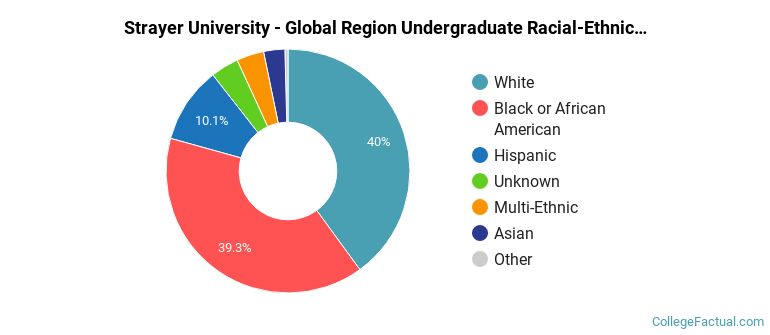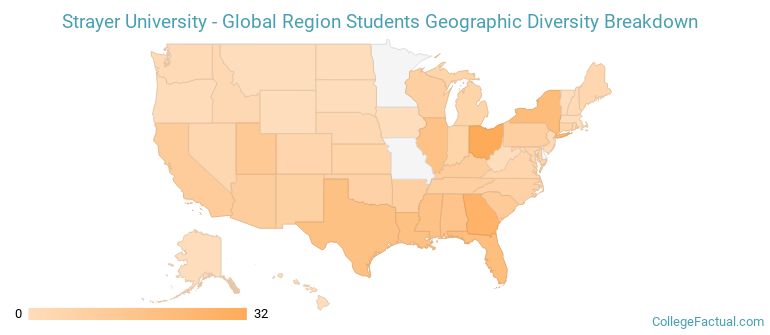 by our College Data Analytics Team
by our College Data Analytics TeamStrayer University - Global Region total enrollment is approximately 10,457 students. 339 are undergraduates and 491 are graduate students.
Male/Female Breakdown of Undergraduates
The full-time Strayer University - Global Region undergraduate population is made up of 56% women, and 44% men.

For the gender breakdown for all students, go here.
Strayer University - Global Region Racial/Ethnic Breakdown of Undergraduates

| Race/Ethnicity | Number |
|---|---|
| White | 170 |
| Black or African American | 92 |
| Hispanic | 36 |
| Multi-Ethnic | 23 |
| Unknown | 9 |
| Asian | 3 |
| Native Hawaiian or Pacific Islander | 2 |
| International | 0 |
See racial/ethnic breakdown for all students.
Male/Female Breakdown of Graduate Students
About 49% of full-time grad students are women, and 51% men.

For the gender breakdown for all students, go here.
Strayer University - Global Region Racial-Ethnic Breakdown of Graduate Students

| Race/Ethnicity | Number |
|---|---|
| White | 208 |
| Black or African American | 166 |
| Hispanic | 47 |
| Asian | 42 |
| Unknown | 13 |
| Multi-Ethnic | 12 |
| International | 1 |
| Native Hawaiian or Pacific Islander | 0 |
See racial/ethnic breakdown for all students.

| Race/Ethnicity | Number |
|---|---|
| White | 4,509 |
| Black or African American | 3,610 |
| Hispanic | 1,118 |
| Multi-Ethnic | 409 |
| Asian | 355 |
| Unknown | 316 |
| Native Hawaiian or Pacific Islander | 44 |
| International | 4 |

There are approximately 6,915 female students and 3,542 male students at Strayer University - Global Region.
Strayer University - Global Region ranks 53 out of 2,183 when it comes to geographic diversity.
100% of Strayer University - Global Region students come from out of state, and 0% come from out of the country.

The undergraduate student body is split among 37 states (may include Washington D.C.). Click on the map for more detail.

| State | Amount |
|---|---|
| Ohio | 32 |
| Georgia | 27 |
| New York | 21 |
| Florida | 20 |
| Louisiana | 18 |
A traditional college student is defined as being between the ages of 18-21. At Strayer University - Global Region, 3.00% of students fall into that category, compared to the national average of 60%.

| Student Age Group | Amount |
|---|---|
| 35 and over | 4,423 |
| 30-34 | 1,759 |
| 25-29 | 1,670 |
| 22-24 | 656 |
| 20-21 | 208 |
| 18-19 | 58 |
| Under 18 | 0 |
Footnotes
*The racial-ethnic minorities count is calculated by taking the total number of students and subtracting white students, international students, and students whose race/ethnicity was unknown. This number is then divided by the total number of students at the school to obtain the racial-ethnic minorities percentage.
References